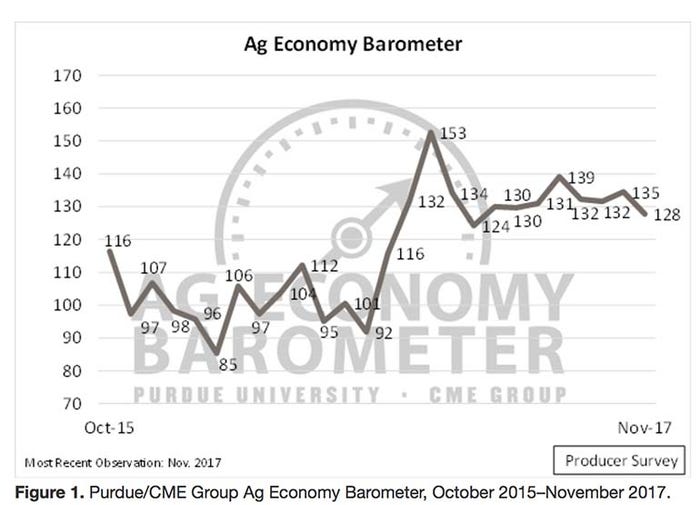December 6, 2017

The Purdue/CME Group Ag Economy Barometer dropped 7 points in November, yet producers remain more optimistic than they were prior to the election of 2016.
The 7-point drop signaled a slump in U.S. agricultural producers’ confidence compared to a month earlier. At a reading of 128, the measure of producer optimism in November was the second weakest observed during 2017 and stood just 4 points above the 2017 low of 124, set in March.
The barometer is based on a monthly phone survey of 400 agricultural producers from across the U.S.

Less Optimism
The November slide in producer sentiment was driven by producers taking a less optimistic view of the future. The Index of Future Expectations declined 10 points compared to October as the index fell to 127. The decline in optimism about future economic conditions stands in contrast to producers’ assessment of current economic conditions, however, as the Index of Current Conditions reading of 129 in November was unchanged from October.
Other results:
The percentage of producers expecting “bad times” for the agricultural economy in the year ahead climbed to 62% on the November survey.
The percentage of producers expecting bad times for the agricultural economy has been increasing since July, when it hit a summertime low of 50%.
The percentage of producers expecting good times for the agricultural economy in the upcoming year dipped to 28% in November, down from 35% in October.
Farmland Values Stabilizing
On a regular basis, producers are asked about their expectations for farmland values. In November, a record low percentage (17%) of respondents indicated they expect farmland prices in their area to decline over the next 12 months.
The decline in producers expecting lower farmland prices was accompanied by a small uptick in the share of respondents (21%) expecting farmland values to turn higher in the year ahead. Notably, for the first time in survey history, more producers expect farmland values to increase in the upcoming year than decline.
In November, the share of producers expecting no change in farmland values reached a life of survey high of 62%, nine percentage points above the previous peak of 53%, set in February 2017. The biggest change in attitudes in recent months has been a shift away from producers expecting farmland values to decline to an expectation that values are likely to stabilize.
Since farmland is a long-run investment, producers were also asked to provide their expectations for farmland values over the next five years.
In November, 46% of producers said they expect farmland values in their area to be higher, whereas only 9% expect lower farmland values five years from now. Interestingly, the percentage of respondents expecting higher farmland values in five years was more than double the percentage of producers expecting higher values in 12 months. Responses to this question imply that there remains strong underlying support for farmland values among producers, even though margins in crop agriculture have been very narrow for several years in a row.
Producers’ Perspectives on Trade
Throughout 2017 questions about agricultural trade have been posed to producers to gain insight into how proposed policy changes are affecting producer sentiment.
On the November survey, producers were asked to rate the importance of agricultural exports to the U.S. agricultural economy and, in a separate question, to rank the importance of the North American Free Trade Agreement (NAFTA) to the U.S. agricultural economy.
When asked about agricultural exports specifically:
60% of producers said exports are “very important."
96% said they were “important” to the ag economy.
When asked specifically about NAFTA, producers were a bit less confident about the importance of the trade agreement to the U.S. ag economy:
24% of producers rated NAFTA as “very important."
70% rated it as “important.”
Perhaps the most glaring difference between producer perceptions about ag exports in an abstract sense and NAFTA, is the big difference in the percentage of respondents providing a neutral rating regarding NAFTA’s importance to the agricultural economy versus the percentage of producers providing a neutral response regarding export’s importance to the agricultural economy. Approximately 10 times as many producers provided a neutral rating to NAFTA’s importance to the agricultural economy as provided a neutral rating to the importance of exports to the agricultural economy.
Source: James Mintert, David Widmar and Michael Langemeier / Purdue/CME Group
You May Also Like




